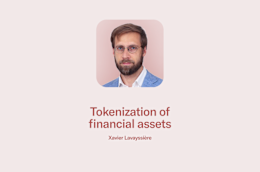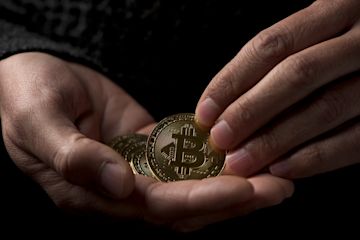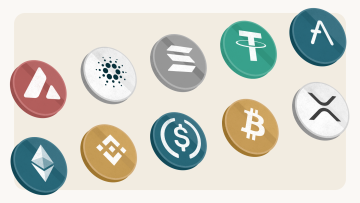Asset tokenization — the process of converting various financial assets such as stocks, bonds, real estate, and commodities into digital tokens — can offer investment opportunities for the general public. Tokenization democratizes access to financial products that were previously less accessible, while also improving the functioning of financial digital infrastructures. As a result, we see startups and institutional projects experimenting. However, this also presents new risks, and adoption remains challenging. To learn more about how tokenization functions and explore emerging trends, read the full article by digital finance expert Xavier Lavayssière.
Tokenization of financial assets
What opportunities does asset tokenization present? By Xavier Lavayssière, expert in digital finance, advising governments and central banks on improving their financial infrastructures.Recent years have seen growing retail investor interest in accessing new financial assets enabled by fintech innovation. Investment apps and cryptocurrencies have exposed the general public to trading. An online frenzy has sparked a retail finance industry, combining simplified financial products and TikTok influencers.An innovation has also appeared: asset tokenization, the conversion of financial assets like stocks and bonds into digital token representations. It may reinforce retail opportunities by offering broader access to financial assets and contribute to modernizing financial market infrastructures. This post explores how tokenization works, key emerging trends, and what challenges remain.What is tokenization?
Tokenization of financial assets refers to the representation of real-world financial assets — such as stocks, bonds, or currencies — using digital tokens. In most cases, these tokens are a trust-minimized representation on a blockchain or distributed ledger technology (DLT).Tokenization has gained traction recently among fintech enthusiasts as a potential way to transform traditional financial markets. Proponents argue that reducing reliance on intermediaries could enhance operational efficiency, reduce settlement errors, provide easier access for investors, and enable greater innovation in financial instruments. However, realizing the benefits of tokenization involves overcoming several technological, regulatory, and coordination challenges.It must be noted that there is a related notion of data tokenization in payments. In that case, a digital token is created to represent sensitive data, such as credit card information. Tokenization reinforces the security of payments.How does tokenization of assets work?
During tokenization, three tracks are conducted in parallel:- The technical track: A digital token is created, which can consist of developing a smart contract that will represent the token. This smart contract is then deployed on a public or private blockchain.
- The legal track: Legal rights are attached to this token. With the tokenization of data, the key element is the link between the asset, the token, and the owner. Each link can be trust minimized or intermediated.
- The commercial track: The newly emitted token is distributed to investors for a price. A digital platform offering secondary trading is generally used, but commercial efforts are required.
Trends in tokenization
Several key trends have emerged in recent tokenization projects:Stablecoins
The first trend is stablecoins. Stablecoins are digital tokens representing a currency, such as the euro or US dollar. In major projects, such as USDC and Tether, tokens are backed by a reserve of an equivalent amount. The Markets in Crypto-Assets Regulation (MiCA) in Europe defines strict rules for such reserves. Stablecoins represent more than $100 billion today.Converting assets
A second trend is labeled “Real World Assets,” where startups convert existing assets into tokens. The most popular category is Treasury bonds, which allow any investor worldwide access to US government debt. Corporate bonds and stocks also find appeal. These Real World Assets generally target crypto investors who want exposure to different types of assets, combining the best of both worlds. There are also attempts to tokenize non-financial products, such as art or carbon credits.
Tokenized financial instruments
A third trend is public and financial institutions creating a tokenized version of financial instruments. In that case, in the long term, the objective is to obtain efficiency gains. For example, the European Investment Bank has issued several European bonds and pound sterling worth hundreds of millions. Other banks, such as UBS, Société Générale, and JPMorgan, have conducted similar operations. They can consist of experimentations with national central banks, large-scale emissions, or as a service to third parties.Remaining challenges for tokenization
Although tokenization is gaining traction, some challenges remain:Weak backing
Many tokens act as representations of assets. For example, a token may signify a fractional ownership claim in a real estate property, rather than being a digitized deed itself. This indirection erodes confidence in the token’s reliability if legal recourse is limited. Projects of tokenization can end up providing no actual ownership or economic rights. Such false promises risk undermining interest in tokenization.For stablecoins acting as tokenized fiat currency, backing reserves are vital. However, Tether’s USDT token has faced questions on whether its stated fiat currency reserves are fully audited. While central bank digital currencies like China’s eCNY could allow 1:1 redemptions into the renminbi, global private stablecoins still confront reserve fidelity challenges.Many early asset tokenization projects have been one-off proof-of-concepts on permissioned blockchains. Transitioning to industrial-grade solutions or public blockchains like Ethereum has uncovered challenges around security, transaction fees, speed, and governance gridlock.Are these technology foundations ready for regulated, mission-critical financial assets? Most existing public blockchains offer very different security models than centralized market infrastructure. Can distributed ledgers match the needs of modern securities settlement finality while retaining trust minimization? Several projects, such as Petale’s Vortex or the Regulated Liability Network, are looking into this.
Token custody tradeoffs
Asset ownership does not map perfectly from traditional securities to tokenized models. Self-custody approaches, where users fully control their own tokens, reflect the ethos of decentralization. However, it can be challenging to guarantee the recovery of assets in case of the loss of private keys or to ensure compliance.Therefore, dedicated custodians may be necessary for regulated institutions to satisfy legal duties. Under such custodial models, specific regulations are required to clarify questions of liability, fiduciary responsibilities, and handling of events like institutional failure.Hybrid options are also emerging, such as multi-party computation schemes that could provide trust-minimized processes without sacrificing compliance or service quality.Fraud
Despite promises to expand financial access, crypto assets have notoriously been associated with fraud, scams, and illicit usage. While most regulatory regimes now mandate investor Know Your Customer (KYC) procedures, phishing or other exploits persist on public chains.Therefore, for tokenization to thrive without losing its benefits, the right processes and regulations will need to be in place to combat fraud and money laundering.Fragmented offers
The proliferation of tokenized financial assets across fragmented, poorly harmonized regulatory regimes hinders development and adoption. Compliance costs and liability concerns result in two approaches by startups: a prudent approach, tightly controlling the assets and investors, or, on the contrary, the selection of permissive jurisdictions when possible, leading to augmented risks.Global regulatory alignment on fundamental concepts around custody requirements, capital reserves, data privacy, and dispute-resolution mechanisms is needed. Understanding tokenized assets as a novel new product class rather than retrofitting existing financial frameworks would match their unique technical qualities and risk profiles.The future of tokenization: harmonization and education
As asset tokenization gains momentum, alignment and common standards are needed to manage risks while encouraging responsible innovation. Education for investors, developers, and policymakers will also be key to avoiding pitfalls and seizing productive opportunities. With thoughtful governance, this phenomenon could profoundly transform financial market infrastructure and participation.



